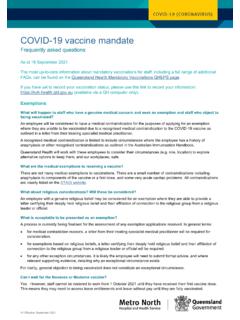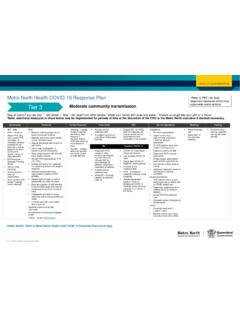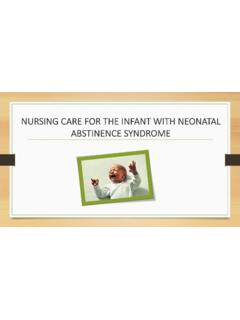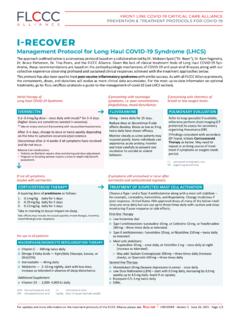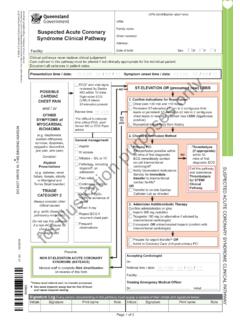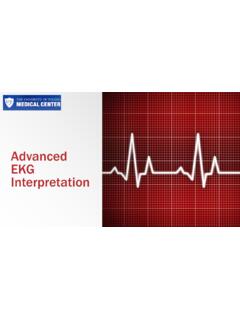Transcription of QuEDS Guide to Admission and Inpatient Treatment
1 QuEDS Guide to Admission and Inpatient Treatment Developed by Queensland Eating Disorder Service ( QuEDS ) This Guide has been developed by Queensland Eating Disorder Service ( QuEDS ) and is supported by current literature (see references 1-22), research and expert opinion. It has been endorsed by the Statewide General Medicine Clinical Network (incorporating Emergency Medicine) and GP Queensland in 2009, the Statewide Mental Health Clinical Network (2011) and reviewed and endorsed by the Queensland Eating Disorder Advisory Group (EDAG) in 2018. In 2014, these guidelines were adapted and incorporated into the Royal Australia & New Zealand College of Psychiatrists (RANZCP) clinical practice guidelines for the Treatment of eating disorders. QuEDS /Metro North Mental Health Service QuEDS Guide to Admission and Inpatient Treatment I Published by the State of Queensland (Metro North Hospital and Health Service), July 2020 This document is licensed under a Creative Commons Attribution Australia licence.
2 To view a copy of this licence, visit State of Queensland (Metro North Hospital and Health Service) 2019. You are free to copy, communicate and adapt the work, as long as you attribute the State of Queensland (Metro North Hospital and Health Service). For more information, contact: QuEDS , Metro North Hospital and Health Service, 2 Finney Road, Indooroopilly Queensland, 4068. Email Phone 07 3100 7500. An electronic version of this document is available at Disclaimer: The content presented in this publication is distributed by the Queensland Government as an information source only. The State of Queensland makes no statements, representations or warranties about the accuracy, completeness or reliability of any information contained in this publication. The State of Queensland disclaims all responsibility and all liability (including without limitation for liability in negligence) for all expenses, losses, damages and costs you might incur as a result of the information being inaccurate or incomplete in any way, and for any reason reliance was placed on such information.
3 V4 Effective: July 2020 Review: July 2022 QuEDS Guide to Admission and Inpatient Treatment II Contents Contents .. ii Queensland Health Eating Disorder Services .. 1 Background .. 1 Involving Family and Carers .. 1 Objectives .. 1 Goals of Inpatient Treatment .. 1 Table 1: QuEDS Indicators for Admission .. 2 Flowchart A: Overview of Treatment for adults with eating disorders .. 3 Table 2: Guide for Emergency Department Clinicians: .. 4 Admission TO MEDICAL WARD .. 5 Table 3: Medical Management .. 5 Management of Medical Complications .. 6 Nutritional Management .. 6 Nutrition Option 1: Best practice and strongly recommended .. 6 Nutrition Option 2: If nasogastric feeding is not possible or delayed .. 7 Nursing Management .. 8 Table 6: Nursing Observations in medical wards .. 8 Guidelines for transfer from medical ward to mental health unit.
4 9 Admission TO MENTAL HEALTH WARD .. 9 Medical Management .. 9 Nursing Management .. 9 Nutritional Management .. 10 The process for the 3 step meal plan is as follows: .. 10 Table 7: 6000kJ/1500kcal Default 3 step meal plan .. 10 Implementation of meal plan .. 11 Nutritional Complications .. 11 Discharge Nutrition .. 11 Leave Guidelines .. 11 Criteria and guidelines for transfer to RBWH adult specialist eating disorders beds .. 12 Discharge Planning .. 12 Appendix I: A Guide to Applying the Mental Health Act 2016 (MHA) and Guardianship and Administration Act 2000 (GAA) for the Assessment and Treatment of Patients with an Eating Disorder 13 Appendix II: Key medical considerations .. 15 Appendix III: Nutrition Flowchart .. 16 Appendix IV: Application of QuEDS guidelines for adults with ARFID .. Error! Bookmark not defined.
5 Appendix V: Supportive Meal Therapy .. 21 Appendix VI: Leave QuEDS Guide to Admission and Inpatient Treatment III Appendix VII: QuEDS Weight 24 Appendix VIII: Specialist Eating Disorder References .. 25 QuEDS Guide to Admission and Inpatient Treatment Version 4 Effective: July 2020; Review July 2022 .1 Queensland Health Eating Disorder Services The Queensland Eating Disorder Service ( QuEDS ) aims to increase the capacity of local services to safely and effectively treat people with eating disorders. QuEDS is available to provide support to treating teams/clinicians throughout Queensland. Local Specialist Eating Disorder Services have been established within the Gold Coast HHS, Sunshine Coast HHS and Cairns HHS. QuEDS may be able to facilitate access to specialist beds at the RBWH if a trial of local Treatment with QuEDS input has not been able to achieve Treatment goals.
6 Additional QuEDS resources and guidelines can also be accessed at: Background Eating disorders are associated with significant psychiatric and medical morbidity. Common eating disorder diagnoses requiring hospital Admission / Treatment include: Anorexia Nervosa (AN), Avoidant Restrictive Feeding Intake Disorder (ARFID*), Bulimia Nervosa (BN), Binge Eating Disorder (BED), Other Specified Feeding or Eating Disorder (OSFED), Unspecified Feeding or Eating Disorder (UFED) and other atypical eating disorders. Further information on diagnoses is covered in the DSM-5 ( ). Effective management requires close collaboration between clinicians working in psychiatric, medical and community settings. The overarching principle that guides the management of patients with eating disorders within Queensland Health (QH) is that patients have the right to access medical and mental health services across the continuum of care including community, Inpatient and specialist services (NEDC National Practice Standards) as determined by their medical and mental health needs.
7 *Further information on the application of these guidelines for ARFID diagnoses is provided in Appendix IV Involving Family and Carers Unless there are contra-indications, or the individual is opposed, family or significant others should be enlisted as partners in the assessment and Treatment process. Given the considerable burden on family, it is important that the family is provided with appropriate support and information (see QuEDS Family Support Guide , QuEDS Patient Support Guide on QuEDS website). Further resources are available at Eating Disorders Queensland - (Clinical Practice Guidelines for the Treatment of Eating Disorders. Royal Australian and New Zealand College of Psychiatrists; 2014.) Objectives The following guidelines will assist treating teams to: Manage the medical and psychological risks and needs of people with eating disorders, Promote coordinated care with a smooth transition across medical, mental health and specialist services, Encourage state-wide consistency in Treatment and management, Include families and carers in the service response to people affected by eating disorders.
8 Goals of Inpatient Treatment The goals of Inpatient Treatment are (in the following order): medical stabilisation; prevention and Treatment of re-feeding syndrome; engagement of carers, family and community supports; nutritional resuscitation and rehabilitation with weight restoration as appropriate; reversal of cognitive effects of starvation so the person can benefit from psychotherapy; to ensure the patient is able to consume adequate nutrition and contain compensatory behaviours both on and off the ward prior to discharge; and arrangement of appropriate outpatient follow-up care. QuEDS Guide to Admission and Inpatient Treatment Version 4 Effective: July 2020; Review July 2022 .2 Table 1: QuEDS Indicators for Admission to Adult Inpatient Beds (>18yrs) If ONE or MORE of these parameters is met at the time of assessment, Inpatient Treatment is advised (2).
9 The list in the table is not exhaustive; therefore, any other medical problems which are of concern should be discussed with the relevant medical team. Contact QuEDS Intake or your local Qld Health Specialist Eating Disorder Service for support during business hours on (07) 3114 0809. Medical Parameters Medical Admission indicated Psychiatric Admission indicated Physical observations Systolic blood pressure <80mmHg <90 mmHg Postural blood pressure# >20mmHg drop with standing Heart rate 40 bpm or > 120 bpm <50 bpm Postural Heart rate# Postural tachycardia > 20bpm^ Temp < < 12-lead ECG Any arrhythmia including: QTc prolongation, or non-specific ST or T-wave changes including inversion or biphasic waves Blood sugar Below normal range (< mmol/L) Pathology Sodium <125 mmol/L <130 mmol/L* Potassium Below normal range (< mmol/L) Magnesium Below normal range (< ) Phosphate Below normal range (< ) eGFR <60ml/ or rapidly dropping (25% drop within a week) Albumin <30 g/L Below normal range (<35g/L) Liver enzymes Markedly elevated (AST or ALT >500) Neutrophils < x 109/L < x 109/L Nutritional Re-feeding risk High see Appendix II Oral intake Grossly inadequate nutritional/fluid intake (<1000kCal/4MJ daily) Unmanageable compensatory behavior (vomiting, exercise, laxatives) Anthropometry Weight loss Rapid weight loss ( 1 kg/week over several weeks) Body Mass Index (BMI)
10 @ BMI <12 kg/m2 BMI 12-14 kg/m2 Other Community supports Not responding to outpatient Treatment * Please note, any biochemical/electrolyte abnormality which has not responded to adequate replacement within the first 24 hours of Admission should be reviewed by a Medical Registrar urgently Medical Admission is recommended if BMI <12 or there are significant abnormalities of physical parameters as indicated in the table above. Psychiatric Admission is indicated if BMI 12-14, or there are other abnormalities of physical parameters that are not of sufficient severity to warrant medical Admission . # Postural HR and BP are measured from lying to standing with a 2minute break. ^Postural tachycardia is only a criterion for Admission if the patient has restricted oral intake or weight loss. @ Body Mass Index (BMI) is Weight (kg)/ Height (m2) see QuEDS Weight Chart Appendix VII NB: For Adolescent Admission parameters please refer to Assessment and Treatment of children and adolescents with eating disorders in Qld see Or 2page summary of Adolescent Admission Parameters on QuEDS internet website For support re: adolescent eating disorder Treatment (business hours) contact CYMHS-EDP Intake on (07) 3397 9077.



